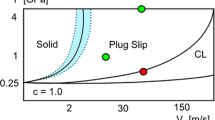Abstract
Controlling frictional behavior in nanoscale sheared systems can be made possible when the relationship between the macroscopic frictional response and the microscopic properties of the sheared systems is established. Here, a new approach is proposed for tuning the frictional response and obtaining desirable frictional properties. This tuning is achieved through shear-induced phase transitions in a mixed lubricant monolayer consisting of a base solvent and an additive. The interaction between the solvent and additive molecules and their relative concentrations are shown to be the major parameters in determining the magnitude of the friction force and the nature of the response (stick–slip or sliding).
Similar content being viewed by others
References
B. Bhushan, J.N. Israelachvili and U. Landman, Nature 374 (1995) 607.
J. Klein and E. Kumacheva, Science 269 (1995) 816.
S. Granick, Phys. Today 52 (1999) 26.
G. Hanhner and N.D. Spencer, Phys. Today 51 (1998) 22.
M.G. Rozman, M. Urbakh, J. Klafter and F.J. Elmer, J. Phys. Chem. 102 (1998) 7924.
G. He, M.H. Muser and M.O. Robbins, Science 284 (1999) 1650.
B.N.J. Persson, Sliding Friction. Physical Principles and Applications (Springer, Berlin, 2000).
F. Family, H.G.E. Hentschel and Y. Braiman, J. Phys. Chem. B104 (2000) 3984.
H.-W. Hu, G.A. Carson and S. Granick, Phys. Rev. Lett. 66 (1991) 2758.
P.A. Thompson, M.O. Robbins and G.S. Greast, Israel J. Chem. 35 (1995) 93.
M.G. Rozman, M. Urbakh and J. Klafter, Phys. Rev. Lett. 77 (1996) 683.
E. Kumacheva and J. Klein, J. Chem. Phys. 108 (1998) 7010.
V. Zaloj, M. Urbakh and J. Klafter, Phys. Rev. Lett. 82 (1999) 4823.
C. Drummond and J. Israelachvili, Phys. Rev. E 63 (2001) 041506.
A.G. Papay, Lubr. Eng. 47 (1991) 271.
T. Kugimiya et al., SAE paper 952348 (1995).
M. Ruths, H. Ohtani, M.L. Greenfield and S. Granick, Tribol. Lett. 6 (1999) 207.
M.L. Greenfield and H. Ohtani, Tribol. Lett. 7 (1999) 137.
A.E. Filippov, J. Klafter and M. Urbakh, Phys. Rev. Lett. (in press).
R.Z. Sagdeev, D.A. Usikov and G.M. Zaslavsky, Nonlinear Physics: From the Pendulum to Turbulence and Chaos (Harwood Academic, 1992).
J.M. Kosterlitz and D.J. Thouless, J. Phys. C: Solid State Phys. 6 (1973) 1181.
H. Yoshizawa and J. Israelachvili, J. Phys. Chem. 97 (1993) 11300.
Author information
Authors and Affiliations
Rights and permissions
About this article
Cite this article
Dudko, O., Filippov, A., Klafter, J. et al. Chemical Control of Friction: Mixed Lubricant Monolayers. Tribology Letters 12, 217–227 (2002). https://doi.org/10.1023/A:1015439010872
Issue Date:
DOI: https://doi.org/10.1023/A:1015439010872




